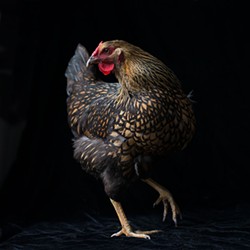The Bounty of the County
Chicken portraits, spore prints and gyotaku by Matthew Rooney
By Gabrielle Gopinath[
{
"name": "Top Stories Video Pair",
"insertPoint": "7",
"component": "17087298",
"parentWrapperClass": "fdn-ads-inline-content-block",
"requiredCountToDisplay": "1"
}
]
"After my bantam Bootsy survived two visits from the neighborhood hawk, I began taking shallow depth-of-field morning poultry portraits," said Matthew Rooney. This month Rooney shows pictures of chickens, local produce and fungi at Ramone's under the series title Myrtletown. He shot the images with a Nikon D800 camera in natural light, and every bud, fowl and 'shroom in the show has been accorded the consideration due a centerfold; it's evident Rooney has art-directed these square-format portraits as meticulously as though he were shooting a fashion campaign.
"I wanted the portraits to be window-lit, with shallow depth of field. The gradient of light flatters the subject, while the narrow focus gives the photo dimension," Rooney said. He decided to center his subjects against black velvet, flooding them with natural light from an adjacent window. The effect of this lighting scheme is chilly and yet soft, like the northern light that slips through windows in Vermeer's paintings of interiors. Cool illumination underscores each gill and feather with a pinstripe of shadow. The birds rise brightly before the ambient darkness. No two hens' plumage is alike.
One alert, long-legged hen slicks her russet feathers snugly over her plump breast, and we see that each individual red feather is tipped with velvety black, like a letter of condolence. Another hen sports a constellation of bluish-white spangles that seem to have been appliquéd freehand against a fringy backdrop of mahogany and gold. She looks like an empress in a Byzantine mosaic. Looking at this photograph, you get why the appellation mille fleur, or "thousand flowers," was coined for bantam chickens like this one, first bred in the Dutch city of Uccle.
Rooney's photographs make a case for the inherent pleasure in the drawing of fine distinctions. Both chickens and fungi come in a dizzying variety, and being able to visually differentiate between breeds or species is vital to mycologists and poultry fanciers alike. These photographs seem designed to reveal how many shades of variation exist within the categories "chicken" and "fungus." While many of the photographs here are individually compelling, the series exists most powerfully as an archive, with each image seen in relationship to the others of its kind.
The fungi portraits began as images created for taxonomic study. Mushroom caps appear severed from their stems and centered on pale gray backgrounds. Some images show caps from above. Others invert the caps to reveal the gills, which are even more crucial for identification but often not readily visible in natural settings. From a distance, they all look like erratically contoured mandalas.
These mushrooms may have been taken out of the forest, but they are obviously still of the forest — wild things with bits of redwood duff and other humus miscellany still clinging to their gills. They look just-picked. One photograph memorably captures the shingled, almost charred appearance of the areola-like dark zone at the center of a deer mushroom's cap. Another foregrounds the labyrinthine complexity of a blewit's in-folded, luminescent gills.
Some of these fungi pictures are actually not photographs of mushrooms at all, but photographs of spore prints. Spore prints are traditionally a key element of mushroom identification in mycological circles. Prints are made by allowing severed mushroom caps to rest on a level surface under controlled conditions. In a matter of hours, the dust-like spores clenched invisibly within the gills release their hold and come to rest in a pattern that replicates the mushroom's gills in exact reverse. The resulting images, variously colored white, beige, black, pale yellow or rose, can look disarmingly like photographic negatives.
"Spore prints and photographs are very similar," Rooney observed. "Both are allowing you to see what's around you." He likened the spore print to early 19th century photographic processes based on the direct exposure of photosensitive materials to the sun. "Like the daguerreotype, where silver was activated by iodine and sunlight and the heated fumes of mercury formed white particulate ... the mushrooms react with light and heat and deposit many hues of color.
"I generally make spore prints in 24 hours on glass, then photograph them and reuse the glass. I have a preference for mushrooms that deposit white spore. The white spore on glass reminds me of historic photographic processes," Rooney says.
In addition to these photographs of prints, the exhibition also includes a couple of actual monoprints made using the brilliantly straightforward Japanese style of printing known as gyotaku, which involves pressing rice paper onto an actual fish that's been inked. In these contact prints of steelhead and salmon, the level of detail the process yields is remarkable. Each scale is rendered with precision, even as the monochrome printing process lends the image a degree of abstraction and formality. You could think of these prints as plainspoken trophies — fish stories that, unlike most, leave no room for exaggeration.
more from the author
-
Nancy Tobin's CRy-Baby Installation at CR
- Feb 22, 2024
-
Truth Units
Bachrun LoMele's Burn Pile/The Andromeda Mirage at the Morris Graves
- Sep 7, 2023
-
Ruth Arietta's Illusory Interiors at Morris Graves Museum of Art
- Aug 10, 2023
- More »

































